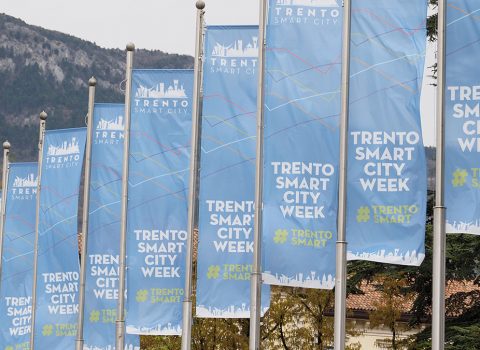
The architects of the future at the Trento Smart City Week
In a “smart” version of Piazza Duomo, the children of the 5th grade of the Vela elementary school (TN) met with FBK researchers to imagine how the city of tomorrow could be
The three-day event dedicated to “citizens in the digital age” in the central square of Trento officially opened today, and what better opening event could there be if not a meeting with the children about the city they would like to live in? The workshop attended by the 5th grade class of Vela used participatory design techniques: teams, old photos of Trento to make children understand the constant change of spaces, and a large city map on which to write, draw or paste their own ideas. All these activities were conducted with the support of the research experience in the field of co-design of the Foundation’s i3 unit: “The main goal of this workshop – Chiara Leonardi, FBK researcher explains – was to encourage children to imagine the future of their city. Today’s experimental activity is part of our research goals, i.e. to include different categories of users in the innovation process, such as older adults, young people, families, including children, in a program that leads to the design of technologies that will improve the life of the cities and the people who live there.”

The kids of the 5th grade of the vela school working with FBK researchers

Trento in the ’60s. The kids had the chance to compare the old pictures with the current status so as to understand the evolution of the city (Source: Trento Library)
The event lasted just over two hours but the ideas were many: some on environmental sustainability, such as the use of electric vehicles equipped with safety sensors instead of cars running on fuels, smart trash cans to encourage citizens to keep the city tidy, larger numbers of trees to make the city greener and to be used as a raw material for building homes. Others more of an economic/inclusive nature, such as the possibility of paying with smiles, or of building houses for the poor. There is also a high level of sensitivity toward safety issues, with great attention to the presence of thieves that should be sent to prison. Among the smartest, and at the same time utopian ideas, was that of the air-powered car, whose unlucky experience on the market children obviously could not know about. Although some proposals may seem outlandish, this is part of the typical design process in which adults are usually involved, but with a paradoxical advantage: “we adults cannot imagine the things that children often suggest,” Paolo Massa, FBK researcher explains – above all thanks to their great imagination, their lack of closures and particular mental schemes, thus allowing more innovative and unusual things to emerge. ”

Co-Design in action
Involving children in the co-design of cities is becoming increasingly strong also in the scientific world, as Michela Ferron, another FBK researcher, confirms: “While in the past they were considered as objects of design, the world of research is currently making children the protagonists in co-designing activities. So now they are increasingly being seen as active subjects since they are the citizens of the future”

At the end of the workshop with all the kids in the square
A trend that has its roots in the recent history of society. Already in 1989, art. 12 of the UN Convention on the Rights of the Child stated: “Member States guarantee to the child capable of discernment the right to freely express his opinion on any matter that concerns them, the opinions of the child must be duly taken into account based on their age and their degree of maturity”. At this point we just have to continue to imagine with them the future they would like, to help them, with the support of research, to make it happen.


